
The Westland Wessex is a British-built turbine-powered development of the Sikorsky H-34. It was developed and produced under licence by Westland Aircraft. One of the main changes from Sikorsky's H-34 was the replacement of the piston-engine powerplant with a turboshaft engine. Early models were powered by a single Napier Gazelle engine, while later builds used a pair of de Havilland Gnome engines.

The Sikorsky H-34 is an American piston-engined military utility helicopter originally designed by Sikorsky as an anti-submarine warfare (ASW) aircraft for the United States Navy. A development of the smaller Sikorsky H-19 Chickasaw (S-55), the H-34 was originally powered by a radial engine, but was later adapted to turbine power by the British licensee as the Westland Wessex and by Sikorsky as the S-58T. The H-34 was also produced under license in France by Sud Aviation.

Helicopter Sea Combat Squadron Seven (HSC-7), also known as the Dusty Dogs, is a United States Navy helicopter squadron located at Naval Station Norfolk, Virginia. They are attached to Carrier Air Wing Three and deploy aboard USS Dwight D. Eisenhower.

Helicopter Combat Support Squadron FOUR (HC-4) was a United States Navy helicopter squadron based at Naval Air Station Norfolk, Virginia. Nicknamed the "Black Stallions", they flew the Sikorsky CH-53E Super Stallion and MH-53E Sea Dragon helicopters.

Helicopter Training Squadron EIGHT (HT-8) is a United States Navy helicopter training squadron based at Naval Air Station Whiting Field in Milton, FL. The squadron's mission is helicopter pilot training for U. S. Navy, U. S. Marine Corps and U. S. Coast Guard Student Naval Aviators and for selected foreign military flight students from basic helicopter flight training through winging. Student Naval Aviators report to HT-8 for helicopter training upon completion of primary flight training conducted in the T-6B Texan II U. S. Navy primary flight trainer. HT-8 flies the TH-73A Thrasher, an

Helicopter Sea Combat Squadron Eight (HSC-8) "Eightballers" is a United States Navy helicopter squadron based at Naval Air Station North Island, San Diego, California. HSC-8 is attached to Carrier Air Wing 11 (CVW-11) and deploys aboard USS Theodore Roosevelt. HSC-8 was redesignated from HS-8 on 28 September 2007.

Helicopter Sea Combat Squadron 25 (HSC-25) "Island Knights" is a United States Navy helicopter squadron based at Andersen Air Force Base, Guam. The "Island Knights" of HSC-25 fly the MH-60S "Knighthawk" helicopter, manufactured by Sikorsky Aircraft Corporation in Stratford, Connecticut.
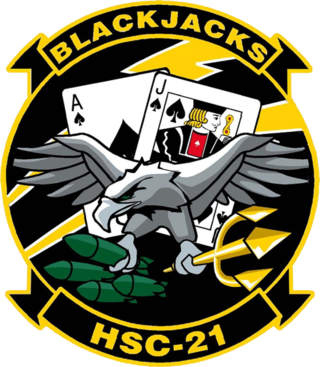
Helicopter Sea Combat Squadron 21 (HSC-21), nicknamed "Blackjacks", is an aviation unit of the United States Navy based at Naval Air Station North Island. HSC-21 is made up of five expeditionary detachments that deploy aboard ships including Combat Logistics Force support ships, Hospital Ships and Amphibious Assault ships, among others. HSC-21 flies the Sikorsky MH-60S Seahawk helicopter.
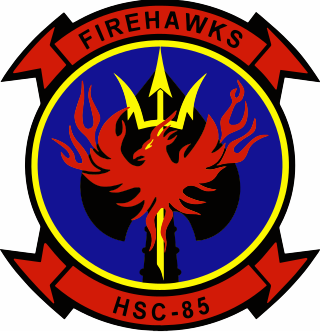
Helicopter Sea Combat Squadron EIGHT FIVE (HSC-85) was a United States Navy Reserve forces helicopter squadron (RESFORON) based out of Naval Air Station North Island in San Diego, California. The "FIREHAWKS" of HSC-85 are Reserve and Active Component Sailors who operate and maintain Sikorsky MH-60S Seahawk helicopters.

Helicopter Sea Combat Squadron THREE , is a United States Navy multi-role combat helicopter squadron based at Naval Air Station North Island in San Diego, California, which operates the Sikorsky MH-60S Knighthawk helicopter to train aircrew and support fleet development on the MH-60S for the Commander Helicopter Sea Combat Wing, U.S. Pacific Fleet. The squadron was established on 1 September 1967 at Naval Air Station Imperial Beach with the Boeing Vertol CH-46 Sea Knight to provide vertical replenishment (VERTREP) services on the West Coast, and was redesignated HSC-3 on 1 April 2005.

The 563rd Rescue Group is a United States Air Force unit stationed at Davis-Monthan Air Force Base, Arizona. The group also controls the rescue squadrons at Nellis Air Force Base, Nevada. It is assigned to the 355th Wing. The group directs flying operations dedicated to personnel recovery and is part of Air Combat Command. The group was activated under its current designation at Davis-Monthan in 2003 to command rescue units in the western United States.
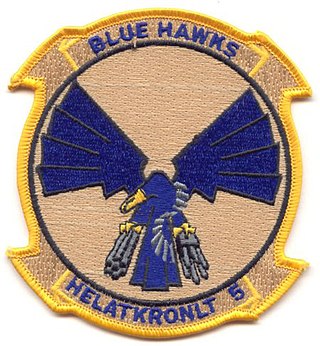
Helicopter Attack Squadron (Light) Five, known by the US Navy designation HA(L)-5, was the initial designation of a Naval Special Warfare and close air support helicopter squadron in the period following the Vietnam War, which, along with its sister squadron HA(L)-4 "Red Wolves", was one of the last two US Navy squadrons using HH-1K "Huey" gunships. In October 1989 the squadron was redesignated Helicopter Combat Support Squadron Special Five (HCS-5), it adopted the name "Firehawks" and it traded in its "Hueys" for HH-60H Seahawk Combat Search and Rescue helicopters. The squadron was deactivated on 13 December 2006.
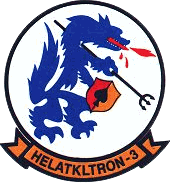
HA(L)-3,, nicknamed the "Seawolves", was a naval special operations aviation squadron unit in the United States Navy (USN) formed in support of United States Naval Special Warfare Command (USNSWC) operations and Mobile Riverine Forces (MRFs) during the Vietnam War.
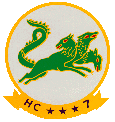
Helicopter Combat Support Squadron Seven (HC-7) was a helicopter squadron of the United States Navy established on 1 September 1967 and disestablished on 30 June 1975.

Helicopter Sea Combat Squadron 2 , also known as the "Fleet Angels", is a helicopter squadron of the United States Navy based at Naval Station Norfolk operating the Sikorsky MH-60S Seahawk. The Fleet Angels are a Fleet Replacement Squadron providing trained MH-60S crew to units on the East Coast.
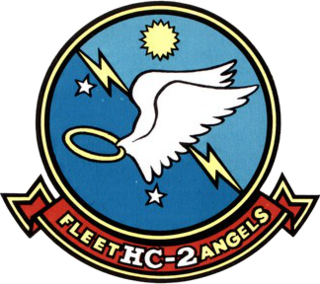
Helicopter Combat Support Squadron 2 (HC-2), also known as the "Fleet Angels", was a multi-role helicopter squadron of the United States Navy based at Naval Air Station Jacksonville. The squadron was established on 1 April 1948 and remained active until disestablished on 30 September 1977.

772 Naval Air Squadron was a Fleet Air Arm (FAA) naval air squadron of the United Kingdom’s Royal Navy (RN) which last disbanded during September 1995. 772 Naval Air Squadron formed as a Fleet Requirements Unit out of 'Y' Flight from 771 Naval Air Squadron at RNAS Lee-on-Solent in September 1939. While the headquarters remained there, floatplanes were operated out of RNAS Portland, however, mid 1940 saw the whole squadron move north to RNAS Campbeltown and roughly twelve months afterwards the short distance to RNAS Machrihanish. The unit moved to RNAS Ayr in July 1944 and became the Fleet Requirements Unit School. In January 1946 the squadron moved to RNAS Burscough in Lancashire, before moving to RNAS Anthorn in Cumberland, in May. It became the Northern Fleet Requirements Unit upon moving to RNAS Arbroath, in June 1947, but disbanded into 771 Naval Air Squadron in October. 772 Naval Air Squadron reformed as a Helicopter Support Squadron at RNAS Portland in September 1974. In September 1977 the squadron took over responsibility for a number of Ships' Flights of Royal Fleet Auxiliary ships. The squadron was used to reform 848 Naval Air Squadron for the Falklands Task Force in 1982, with the Ships' Flights absorbed into 847 Naval Air Squadron. In August 1982 it took on the Anti-Submarine Warfare Flight from 737 Naval Air Squadron and between 1983 - 1985 a Search and Rescue Flight operated out of RNAS Lee-on-Solent.

















